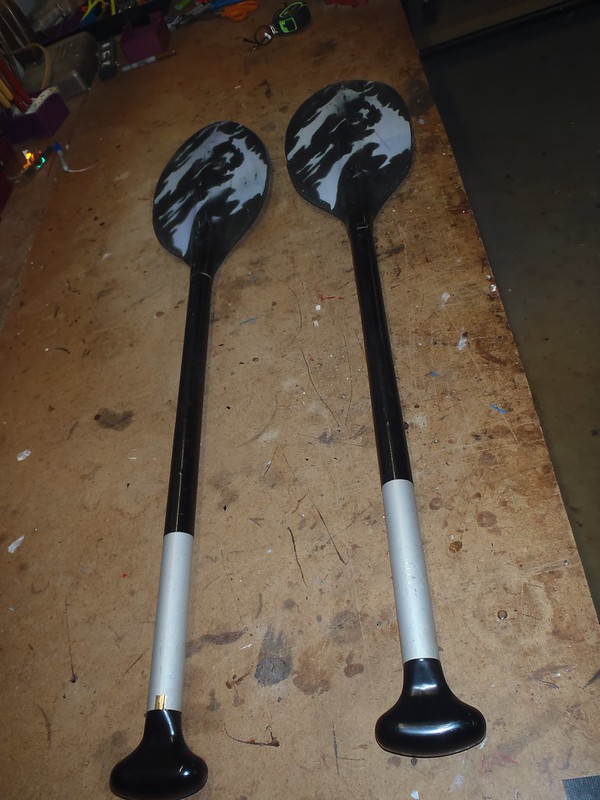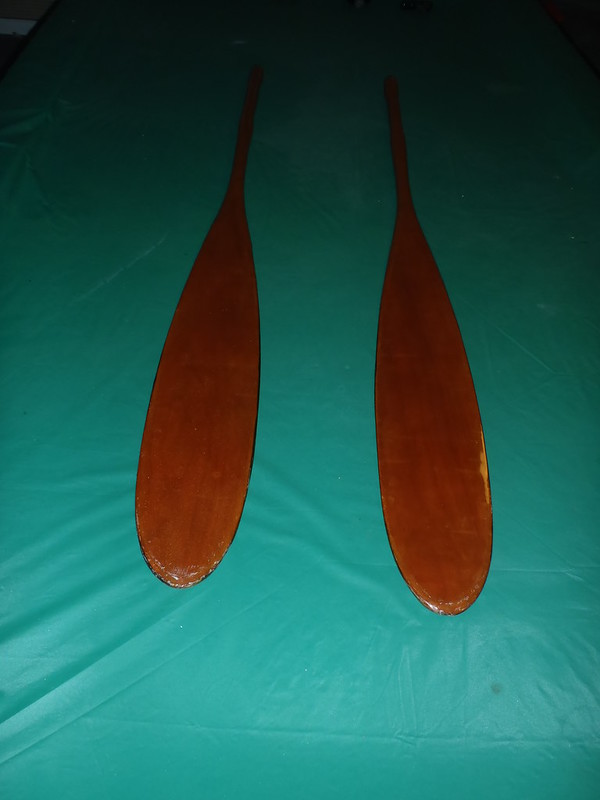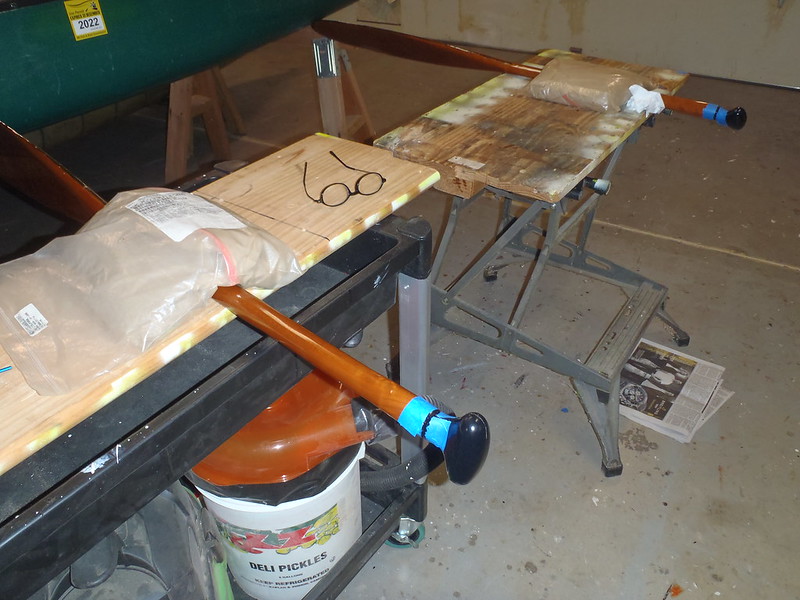G
Guest
Guest
Ainsworth paddle conversion, Take II
 P5130009 by Mike McCrea, on Flickr
P5130009 by Mike McCrea, on Flickr
I can’t do much about the length, weight and material. I can do something about the lopsidedness. Those Ainsworth blades were originally symmetrical, I had to carve curve one side to eliminate a busted chunk, and then need the other blade reshaped similarly, which fortunately was in the correct asymmetrical orientation for a double blade.
How that blade was broken is a mystery, that is some tough plastic; I think you would have to drive over it to break it
Continuing down Glenn’s asymptotical path I re-reshaped the Ainsworth blades symmetrical. As encountered on the first blade reshaping years ago there is a 2” wide aluminum spine running the length of that blade.
The cut end of that aluminum spine was visible on the ends of the originally re-shaped blades, and will be again. Less so after I’m done and paint the exposed metal black.
Some trial and error curve tracing with a gold Sharpie, trying to keep as much blade intact as possible with symmetry, followed by cutting coping saw curves cut down to that spine, a hacksaw through the aluminum center and I have a nearly symmetrical blade. Aluminum spine not yet cut off.
 P6090008 by Mike McCrea, on Flickr
P6090008 by Mike McCrea, on Flickr
I wasn’t worried about achieving perfect symmetry on the saw cuts; a little action with the 1” belt sander to round out and smooth off the blade edges, and a couple hand finishing swipes with 120 for a better round over, and presto
 P6100010 by Mike McCrea, on Flickr
P6100010 by Mike McCrea, on Flickr
Both blades are now 8” x 15”. I was sort of freehanding the curves, so one is rounder, one more teardrop.
That took all of 15 minutes to cut and sand. Time well spent; they would now make indestructible kid paddles in the bow of a backwards tandem.
 P6100011 by Mike McCrea, on Flickr
P6100011 by Mike McCrea, on Flickr
A coat of black paint on the exposed aluminum spine and those shortyshorts will be done.
 P6100012 by Mike McCrea, on Flickr
P6100012 by Mike McCrea, on Flickr
The last two once-upon-a-time double blades still need handles, the solid cherry Nashwaaks. Currently 50” without new grips, closer to 52 with handles added. Long, slender 5’ x 25” blades.
 P6100015 by Mike McCrea, on Flickr
P6100015 by Mike McCrea, on Flickr
I don’t see me coming up with DIY wood grips, so the black plastic Mohawks will have to do.
 P6100018 by Mike McCrea, on Flickr
P6100018 by Mike McCrea, on Flickr
A question for more experienced single bladers – given a choice between a tee grip and a pear grip which would you close for those paddles, and why?
 P5130009 by Mike McCrea, on Flickr
P5130009 by Mike McCrea, on FlickrNothing beats a 43" metal and plastic paddle with a lopsided blade. And it's heavy, to boot.
I can’t do much about the length, weight and material. I can do something about the lopsidedness. Those Ainsworth blades were originally symmetrical, I had to carve curve one side to eliminate a busted chunk, and then need the other blade reshaped similarly, which fortunately was in the correct asymmetrical orientation for a double blade.
How that blade was broken is a mystery, that is some tough plastic; I think you would have to drive over it to break it
Continuing down Glenn’s asymptotical path I re-reshaped the Ainsworth blades symmetrical. As encountered on the first blade reshaping years ago there is a 2” wide aluminum spine running the length of that blade.
The cut end of that aluminum spine was visible on the ends of the originally re-shaped blades, and will be again. Less so after I’m done and paint the exposed metal black.
Some trial and error curve tracing with a gold Sharpie, trying to keep as much blade intact as possible with symmetry, followed by cutting coping saw curves cut down to that spine, a hacksaw through the aluminum center and I have a nearly symmetrical blade. Aluminum spine not yet cut off.
 P6090008 by Mike McCrea, on Flickr
P6090008 by Mike McCrea, on FlickrI wasn’t worried about achieving perfect symmetry on the saw cuts; a little action with the 1” belt sander to round out and smooth off the blade edges, and a couple hand finishing swipes with 120 for a better round over, and presto
 P6100010 by Mike McCrea, on Flickr
P6100010 by Mike McCrea, on FlickrBoth blades are now 8” x 15”. I was sort of freehanding the curves, so one is rounder, one more teardrop.
That took all of 15 minutes to cut and sand. Time well spent; they would now make indestructible kid paddles in the bow of a backwards tandem.
 P6100011 by Mike McCrea, on Flickr
P6100011 by Mike McCrea, on FlickrA coat of black paint on the exposed aluminum spine and those shortyshorts will be done.
 P6100012 by Mike McCrea, on Flickr
P6100012 by Mike McCrea, on FlickrThe last two once-upon-a-time double blades still need handles, the solid cherry Nashwaaks. Currently 50” without new grips, closer to 52 with handles added. Long, slender 5’ x 25” blades.
 P6100015 by Mike McCrea, on Flickr
P6100015 by Mike McCrea, on FlickrI don’t see me coming up with DIY wood grips, so the black plastic Mohawks will have to do.
 P6100018 by Mike McCrea, on Flickr
P6100018 by Mike McCrea, on FlickrA question for more experienced single bladers – given a choice between a tee grip and a pear grip which would you close for those paddles, and why?






